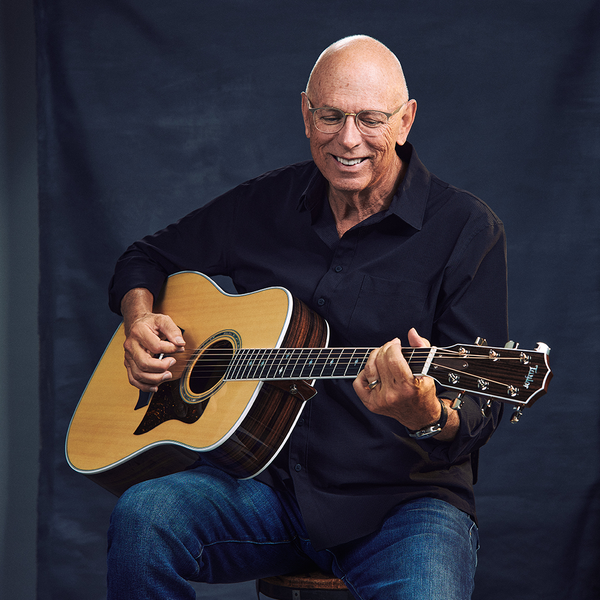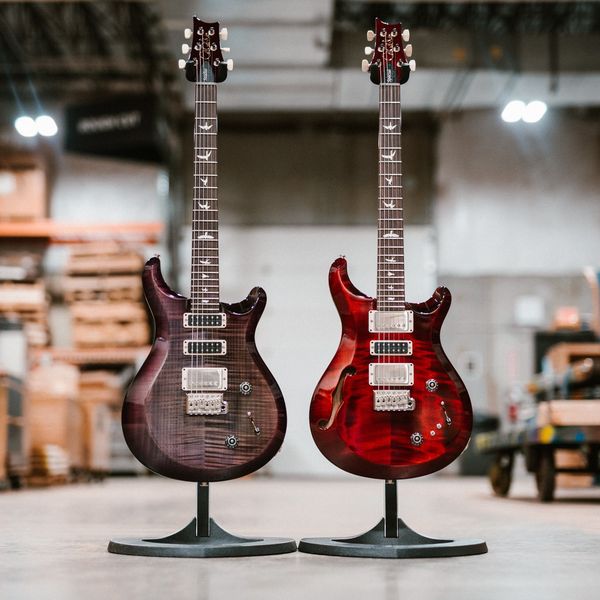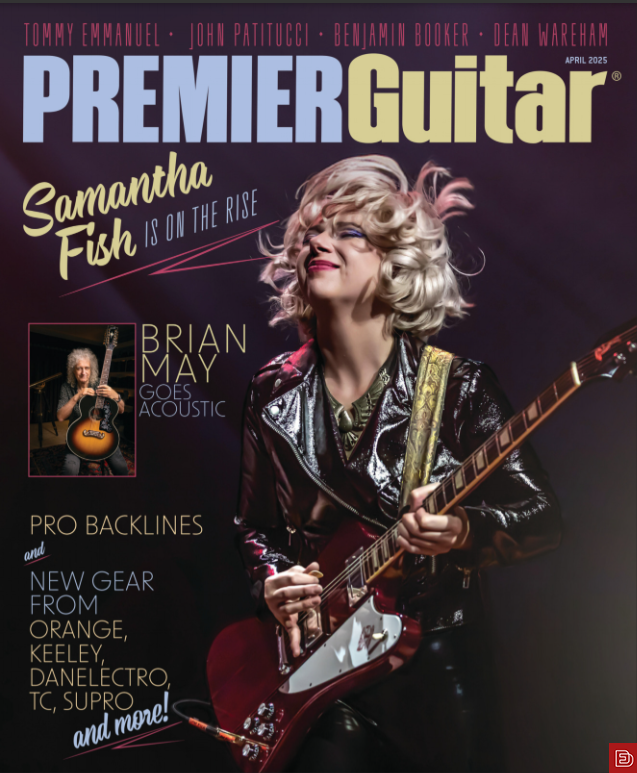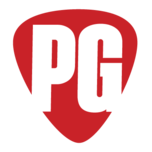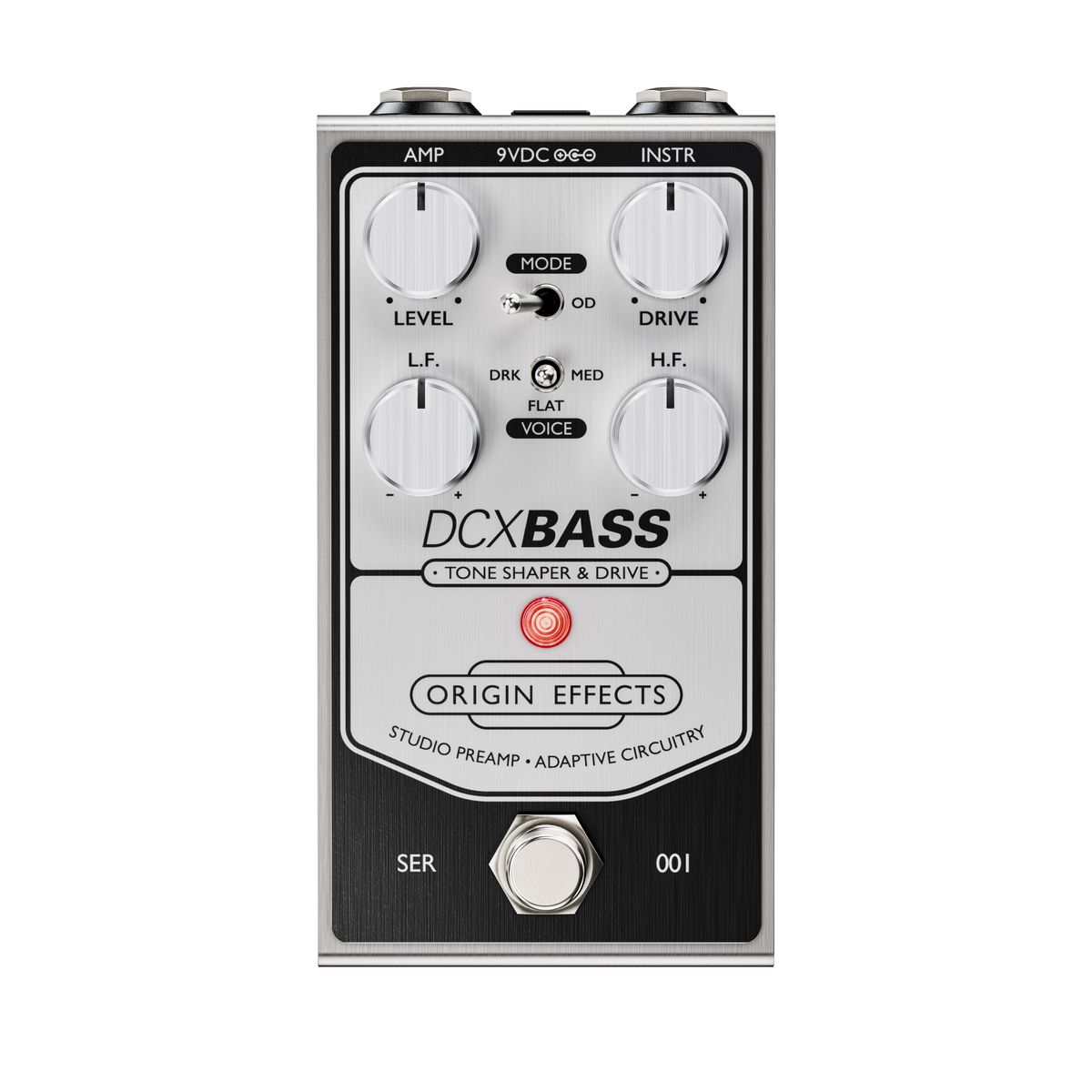
Superb preamp and drive tones combine in a bass utility knife that’s built to last.
Versatile as preamp or overdrive. Built like a tank and feels indestructible. Quiet operation. Very easy to dial in sounds.
Slightly heavy. Could benefit from an XLR out.
$319
Origin Effects Bass DCX
origineffects.com
Origin Effects grabbed the attention of the bass community when they launched their Cali76 compressor, which is now widely acknowledged as an industry standard. Last year the company made another splash among bass players with the release of their BASSRIG Super Vintage and BASSRIG ’64 Black Panel pedals—recreating vintage tube bass tones with impressive accuracy. In a time when much of the musical instrument industry is going digital and embracing the potential of programmability and lighter, more compact products, Origin’s offerings remain stubbornly analog and vintage in look and feel. That’s certainly the case with the DCX Bass, a preamp that’s inspired by the legendary Universal Audio 610 recording console. Though some brave manufacturers admirably emulate the UA 610 in digital form, Origin didn’t seek to imitate the 610 down to the last detail. Instead, they used the 610 as a jumping-off point to create this preamp, EQ, and drive optimized for bass.
A Preamp of Many Hats
Like the UA 610 preamp, the DCX Bass adds color to a signal as well as precise control over level and EQ. It also enhances playing dynamics. Like many other Origin pedals, the DCX Bass is both simple and feature-rich. Four knobs regulate output level, drive, and low-frequency and high-frequency bands, and between those controls you’ll find two switches. A mode switch changes the function of the pedal from EQ mode to overdrive mode. The voice switch lets the user choose from dark, flat, and medium settings. It’s pretty straightforward on the surface. But when you plug in you realize the options and combinations add up to much more than meets the eye.
Cleaning Up in the Studio
Most bass players are accustomed to using straight-to-console tones without effects. But that rarely means your signal sees just a DI. There is almost always some compression and a slight, barely audible harmonic saturation from the desk that makes the low end sound magical. In my own studio work, I use this sound 80 to 90 percent of the time, so I’m pretty used to the way a good board preamp affects my basic tone. Eager to hear how the DCX approximated that sound, I plugged in a Yamaha bass with just a P-style pickup engaged, put the pedal in EQ mode, the voice switch in dark mode, set the drive at 11 o’clock, and both EQ controls at 2 o’clock.
“With the drive knob all the way up and the voice switch set to flat, I was rewarded with a thick overdrive tone with pronounced upper transients that are not at all harsh.”
In this setting, the DCX Bass added perceptible extra warmth. I didn’t hear extra low end, exactly, but I sensed a slower attack that made the bass feel just a little bigger and a bit more like clean ’70s direct tones. When I was moving across the frets on a bass with fresh strings, the fret noises sounded slightly more musical and less harsh—something I always appreciate in tube-driven studio gear. I was very pleased to feel that same sensation from a non-tube-equipped pedal.
Through the Gearbox, Into Overdrive
Flipping the mode switch over to OD transforms the DCX Bass into a roaring rock monster. With the drive knob all the way up and the voice switch set flat, I heard thick overdrive tone with pronounced upper transients that were not at all harsh. And even though the pedal doesn’t have a blend control, the low end remains solid when you use the pedal as a pure drive. To my ears, the drive tone lands squarely in the middle between a darker fuzz and a very bright distortion, like you might hear from Billy Sheehan. When I ran this extreme setting through an amp at a show, it just sounded gloriously like vintage indie rock, and my bandmates shot me smiles of approval.
Middle Ground
One task that can be difficult for many bass overdrives is generating a convincing “barely there,” kind of low-gain drive—the feeling that you get when 10" speakers are just starting to break up a little. I use this tone frequently. And by picking an Epiphone Viola Bass with flatwounds, I got it by switching the mode back to EQ, reducing the drive, and boosting the high frequency to give extra life to the flatwound tone. A palm-muted groove helped generate just the right amount of subtle dirt on the attack. In some ways, it’s the kind of tonality that can be felt by a player as much as heard. It guides you into different playing spaces, and it both sounds and feels great.
The Verdict
Origin’s DCX Bass is supremely usable in a day-to-day, professional playing environment. It’s quiet and free of extraneous noise. Even the most extreme settings never feel exaggerated or redundant, and the clean, warm sounds can make you play like you’re riding in the bench seat of an old Cadillac, going on a slow Sunday drive, without a care for who is behind you honking. The construction inspires confidence and roadworthiness. And whether you decide to use it as an always-on preamp or an engage-when-needed drive pedal, it is a capable tone-shaping piece—especially in a live setting, where rackmount, vintage studio gear is not an option.
- Origin Effects RevivalDRIVE Review ›
- Bass Pedal Wars ›
- Bass Pedals: Basic to Playhouse ›
- 10 Affordable Bass Preamps - Premier Guitar ›
Brent Mason is, of course, on of the most recorded guitarists in history, who helped define the sound of most ’90s country superstars. So, whether you know it or not, you’ve likely heard Mason’s playing.
Professional transcriber Levi Clay has done the deepest of dives into Brent Mason’s hotshot licks. At one point, he undertook the massive project of transcribing and sharing one of Mason’s solos every day for 85 or so days. Mason is, of course, on of the most recorded guitarists in history, who helped define the sound of most ’90s country superstars. So, whether you know it or not, you’ve likely heard Mason’s playing. Levi shares the insight he gleaned from digging deep, and he tells us what it was like when they shared a stage last year. Plus, Levi plays us some great examples of Mason’s playing.
For the first time ever, two guitar greats, John 5 and Richie Kotzen will be heading out on the road this year. The tour will launch October 16 and run through November, hitting markets across the U.S.
Find the full tour itinerary right plus a link for tickets & VIP, including additional dates featuring John 5 only. Reserved seating tickets will go on sale Friday May 16 though a fan presale will begin today at noon local time and fans are strongly encouraged to buy early to get the best seats.
Meet and Greets for both artists will be available. For John 5 please go to: https://john5store.com/collections/vip.
Today, John 5 also announces more details of his anticipated new album. Called The Ghost, it will be released October 10 and is led by the new track “Fiend,” featuring Kenny Aronoff.
John 5 continues running public tours this month for his Knights In Satan’s Service Museum of KISS Memorabilia in Los Angeles, California. Guided tours are open to the public for one month only (with a possible expansion). Current dates available are May 12-16, May 19-23 and May 27-30. Each will be led by John 5 himself who will provide tons of rich detail and answer any questions. Secure your place HERE.
JOHN 5 continues to tour with Mötley Crüe including an upcoming residency in Las Vegas in 2025.RICHIE KOTZEN &
JOHN 5 FALL 2025 TOUR
October 16 El Cajon, CA @ Magnolia
October 17 Riverside, CA @ Fox Performing Arts
October 18 Roseville, CA @ Goldfield Trading Post
October 19 San Jose, CA @ The Ritz
October 21 Phoenix, AZ @ Celebrity Theatre
October 22 Albuquerque, NM @ KiMo Theatre
October 24 Dallas, TX @ Granada Theater
October 25 Leander, TX @ The Haute Spot
October 27 New Orleans, LA @ House of Blues
October 28 Memphis, TN @ Minglewood Hall
October 29 Nashville, TN @ Fogg Street Lawn Club
October 30 Atlanta, GA @ Variety Playhouse
October 31 Orlando, FL @ House of Blues
November 1 Fort Lauderdale, FL @ Culture Room
November 2 Clearwater, FL @ Capitol Theatre
November 4 Richmond, VA @ The National
November 5 Leesburg, VA @ Tally Ho Theater
November 6 Patchogue, NY @ Patchogue Theatre
November 11 Glenside, PA @ Keswick Theatre
November 12 Derry, NH @ Tupelo Music Hall
November 13 Foxborough, MA @ Six String Grill & Stage
November 14 Stroudsburg, PA @ Sherman Theater
November 15 Lorain, OH @ Lorain Palace Theatre
November 16 Columbus, OH @ The King Of Clubs
November 17 Warrendale, PA @ Jergels
November 19 Wyandotte, MI @ District 142
November 20 Flint, MI @ The Machine Shop
November 21 Fort Wayne, IN @ Piere’s
November 22 St. Charles, IL @ Arcada Theatre
November 23 Belvidere, IL @ Apollo Theatre
November 25 Denver, CO @ Oriental Theater
November 29 Pioneertown, CA @ Pappy & Harriet's*
*John 5 only
AEROSMITH guitarist and songwriter JOE PERRY is set to return to the road for a series of August performances with THE JOE PERRY PROJECT. The 8-date run kicks off August 13 in Tampa, FL and wraps August 23 in Port Chester, New York, with an August 19 performance in PERRY’s Boston hometown (see the itinerary below). For the North American trek—which marks the first solo shows for PERRY this year—the legendary guitarist will be joined by his Aerosmith bandmates Brad Whitford (guitar) and Buck Johnson (keys), along with The Black Crowes’ Chris Robinson (vocals), and Stone Temple Pilots’ Robert DeLeo (bass), and Eric Kretz (drums).
“Well…it’s time to let the music do the talkin again,” PERRY says. “I’m really excited about the JPP line up this year!!!! Most of these guys played with me at The Roxy in L.A. at the debut event for my latest solo album [Sweetzerland Manifesto] in January 2018. They’re all busy as hell but thankfully they’re able to carve out some time for this run. And I’m not only lucky enough to have Brad Whitford onstage with me but Chris Robinson of The Black Crowes! [who sang ‘Fortunate One’ on Sweetzerland Manifesto MKII], Robert DeLeo and Eric Kretz from STP!!! and Buck Johnson who plays keys and sings with Aerosmith, the Hollywood Vampires, and is also a solo artist in his own right.”
For the shows, the Rock and Roll Hall of Fame inductee says “the set list is gonna include my fav JPP cuts, STP, Black Crowes, and with Brad we’ll be hitting the Aero hits and some deep cuts and then ya never know!!!! Gonna be a BLAST, and if you’ve ever been to one of my shows you know the words GARAGE BAND on STEROIDS come to mind! See you there!!!!”
DATE | LOCATION | VENUE |
Wednesday, August 13 | Tampa, FL | Seminole Hard Rock - Tampa |
Thursday, August 14 | Hollywood, FL | Seminole Hard Rock - Hollywood |
Saturday, August 16 | Toronto, ON | HISTORY |
Sunday, August 17 | Muskoka, ON | Kee to Bala |
Tuesday, August 19 | Boston, MA | Wang Theatre |
Wednesday, August 20 | Hampton Beach, NH | Hampton Beach Casino Ballroom |
Friday, August 22 | Mashantucket, CT | The Premier Theater at Foxwoods Resort Casino |
Saturday, August 23 | Port Chester, NY | Capitol Theatre |
A sample page from the author’s analog log.
Seasonal changes are tough on your acoustic. Here’s how you can take better care of your prized instrument.
As you read this, spring is in bloom in most of the US, or maybe it has been for some time. I’m timing this column specifically to ask acoustic guitarists, in this season of increasing humidity and comfortable conditions, to prepare for what’s coming. It’s never too soon, and time flies. Before you know it, we’ll be back to the maintenance phase and you might be blowing up the phones of your local guitar shops, luthiers, and techs. I’m here to encourage a decidedly old-school approach to preventative guitar maintenance, and yes, it starts now.
Why, you ask? Well, as the lead luthier at Acoustic Music Works, I can tell you that in my nearly 15 years in this position, this was the worst winter ever for preventable repairs on acoustic guitars. Fret sprout, bridge lifts, top sink, soundboard cracks, back cracks, loose binding, general malaise… These hit us very hard in the winter that spanned 2024 and 2025. Am I complaining? On the one hand, no. This is part of how we make our money. On the other hand, yes! Repair schedules related to dryness and humidity issues can stretch into weeks and even months, and nobody wants to be without their favorite instruments for that amount of time. With a little thoughtfulness, however, you might get through next winter (and every one thereafter) without hefty repair bills or time apart from your musical companion.
Our preparation is going to start with an unlikely but very important guitar accessory: the humble notebook. Plain, lined, grid, day planner… it doesn’t matter. We all need to actively participate in our instrument maintenance, and in my experience, fancy apps that track humidity via Bluetooth breed a kind of laziness, a feeling of safety that might prevent us from actually physically looking in on conditions. Better we keep an analog, well, log, so that we know where things stand, and I suggest checking in daily.
“This was the worst winter ever for preventable repairs on acoustic guitars.”
Track your relative humidity, both in the case and in the room where your instruments mostly reside, but also take notes on your action height, top deflection (StewMac has some great tips for measuring this) and anything related to playability that you believe you can observe empirically.
Dryness is the root cause of most guitar issues that manifest in the fall and winter months. Symptoms of dryness include sharp fret ends, falling action and dead frets, sunken top around the sound hole, and cracks and bridge lifts. With your trusty notebook, you’ll get a feel for the sensitivity level of your instrument, and that knowledge is power!
A few other basic implements will not only assist you in your observations, but may also satisfy your need to buy guitar-related things (at least for a minute). Getting quick and comfortable with a fret rocker is a great skill to have, and is invaluable in diagnosing buzzes due to high frets or frets that have come unseated due to dryness. A well-calibrated relief gauge might seem luxurious, but it can prevent you from making unnecessary or extreme truss rod adjustments. A string action gauge, or even a simple machinist’s rule or set of feeler gauges, will help you keep track of your action. Get a three-pack of hygrometers so you can average their readings, rather than depending on one.
Lest we forget: A guitar can not only be too dry, it can also be too wet. By beginning your maintenance diligence in the spring/summer, you’ll also be able to tell if your instrument is the victim of a too-humid environment. The signs of over-humidification are subtle: Your action may rise from a puffed-up top, and in extreme cases, glue joints could begin to fail. In my experience, an over-humidified guitar will suffer from dulled tone, almost like a sock in the sound hole. If you’re sensing a lack of clarity in your guitar all of a sudden, start with new strings. If it persists, it might be due to over-humidification, and you may want to introduce a desiccant to the case for a time. The more lightly built your guitar is, the more sensitive it will be to seasonal changes.
By getting into these habits early, you’ll be empowered by knowing your instrument more intimately. You’ll understand when and why changes in tone and playability might have occurred, and you’ll hopefully save on repair bills year-round. Feel free to reach out with any questions. Who knows? I might just send you a notebook with an AMW sticker on the cover!


